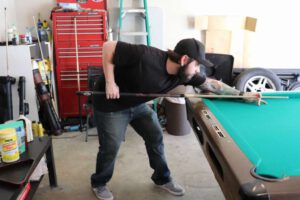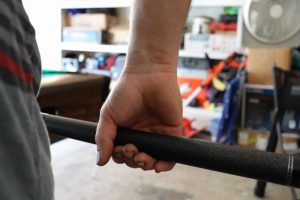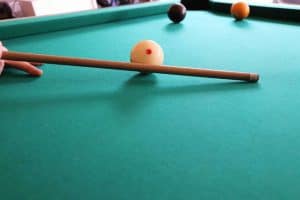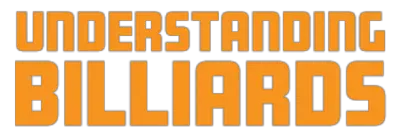I play in several pool leagues and because of that I get to see a lot of new beginner players join, and they all seem to struggle with the same issues. I get asked a lot by them to give them advice on how to improve, so that got me thinking and I came up with four mistakes that I see almost every beginner player has. If any beginner-level player can overcome these common issues they will be set up for success.
Most of these common mistakes that I see new players make sound simple, but I see players make these same mistakes over and over again, and they will not improve their game until they can overcome them. These four mistakes include:
- Not understanding the fundamentals, how to set up properly such as your stance, grip on the cue, and your stroke.
- Rushing your shot, not taking your time to evaluate your options, and make sure you are aligned properly.
- Hitting the ball way too hard, only hit as hard as the shot is required.
- Not playing any defense, only trying to make the ball rather than playing strategically.
These four mistakes will hold your skills back until you can overcome them. I will break down each one of the common mistakes that beginner players struggle with and explain why they are hurting your game. I will also give some tips and advice on how to address these issues and overcome them.
#1 Improper Fundamentals
The biggest problem for beginner players is not having proper fundamentals. By this I mean they do not have a consistent routine for every shot, and they are not doing everything the same for every shot like they should be doing. By having the same exact process for very shot, allows you the ability to streamline the setup because you will not have to think about it after so many times of doing it, it becomes automatic.
Understanding the proper billiard fundamentals is critical to becoming a better and more consistent player. The biggest reason for most players skipping over these is because they underestimate the importance of them and want to learn the cool advanced shots that you see the professional making like jump shots and crazy-looking masse shots.
Sure, practicing the same fundamentals repeatedly can become boring but it is through this repetition that it gets programmed into your brain so much that you will not even have to think about making sure you are setting up for your shot properly it will just happen automatically. These fundamentals that I am referring to are your stance, grip, and stroke.
Stance
Think of your stance as the foundation, without a proper and stable foundation everything else will fall apart. This is so true; your stance is all about aligning your body with your shot to allow for the least amount of movement necessary to implement the shot. The more movement your body is doing the more risk for something to go wrong. By minimizing the body’s movement your are increasing the likelihood that everything will go according to plan.
Most beginner players don’t think about their stance their only focus is on the object ball they are trying to make. Your stance if done properly will make sure your body is aligned with the shot minimizing any room for error. Your stance should be the same for every shot you take, it should be balanced and stable.
To set up your stance properly, you need to understand what the shooting line is. The shooting line is the imaginary line that runs from the pocket you want to make the ball into to the object ball. Now imagine that line through that position on the object ball now through the cue ball and off the table onto the floor. Be able to visualize this line is key to setting up your stance.

Now that you can visualize this line on the floor, you will want your back foot to be on this line, and your front foot just off the side of it about shoulders distance apart or as wide as you feel comfortable with and still stable. This allows your hips to face the direction of the shot keeping your back foot, shoulder, chin, and bridge hand all aligned onto the shooting line.
When shooting you should have you cue right below your chin and you should be as low as you can be to the table to keep the cue as parallel to the table as possible. For every shot this same setup needs to happen, at first this may seem like a lot of work for just setting up a shot, but by implementing this same setup before each shot it will become easier and you won’t have to think about it anymore.
Grip
The grip on the cue is very important and a overlooked fundamental in the eyes of new players. Your grip on the cue should be very light, think of cue as just resting in your hand, it should not be a tight grip. When holding your cue your wrist should not have any tension, and your thumb should be pointed towards the ground.
I recommend only griping the cue with your index finger and thumb, and then just resting the cue on top of the rest of your fingers. Your wrist should not twist or tighten during the stroke. By tightening your grip, you are losing power in your stroke as well as hindering your follow-through of the stroke.

There are times where having a tighter grip will be beneficial such as jump shots and masse shots, but for the majority of your shots on the table should be with a loose grip.
Stroke
The stroke is the most important fundamental by far. Having a consistent stroke is necessary to being able to control the contact point of the tip of the cue and the cue ball. If your stroke is always changing you will never be able to accurately hit the cue ball in the intended area.
Some common problems I see new players have with their stroke are they’re dropping their shoulder during the stroke, standing up before they have finished their stroke, or not following through the cue ball. Your stroke should be one continuous motion, the cue should accelerate smoothly and should not stop until it has made contact through the cue ball and touched the table. Think of your arm from your elbow down as a pendulum swinging back and forth, this should be the only part on your body that is moving during the stroke.

I see a lot of players try to stop the stroke after it has hit the cue ball thinking that was all of the stroke but by doing this you are hindering the power behind the shot and especially when it comes to the transfer of any spin onto the cue ball by not finishing the stroke. This is what I am referring to when I am talking about the follow-through.
Do not stand up from your shot until the balls have stopped moving on the table, this may seem a little extreme but it is good practice. Doing this repeatedly it will prevent you from starting to stand up before you have finished your follow-through.
Start with practicing your stroke softly and work your way up to hitting harder, make sure you are doing everything correctly. When more speed and power get behind your stroke any unnecessary movements can cause you to mishit the cue ball. This is when I see a lot of players dropping their shoulder which will cause the tip of the cue to move upwards on the cue ball.
#2 Rushing the Shot
Trying to shoot too fast can cause many problems for any skilled player let alone a beginner. By rushing your shot you are asking for something to go wrong. I know when you start making a few balls in a row your momentum picks up and you want to keep it going but this is a mistake that I see way too often. Slow down and take a pause between every shot.
Rushing your shot can cause you to:
- Stand up in your stroke, causing you not to finish following through your stroke, and potentially missing the intended contact point on the cue ball.
- Doing no practice strokes to make sure you are aligned properly before you shoot.
- Focusing more on the position for the next shot rather than the shot you are currently taking causing you to miss the shot.
- Getting down for your next shot before the cue ball has stopped rolling causing you to not be aligned properly.
I recommend after every shot to step back away from the table, rechalk the tip of your cue and reevaluate the table layout. Doing this it will give you time to think about your next shot, make sure your tip is chalked, and allow you to align your body with the next shot.
It sounds like common sense but when you are in a match you are not always thinking clearly. You get in a rhythm and you do not want to break the rhythm. I use to struggle with this a lot, and it use to cause me to miss shots I would never normally miss.
#3 Hitting the Ball Too Hard
I know it feels really good to slam the cue ball into the object ball and making the shot, its something about that that makes the shot feel better but it is a rabbit hole you do not want to get stuck in. Hitting the ball hard will cause more problems than it will solve.
When you hit hard, you can lose control over the cue ball, making it harder to position for your next shot, and you have a greater chance of the cue ball finding its way into a pocket for a scratch. Hitting softer allows you to easily predict where the cue ball will go after contacting the object ball, making it easier to string together shots in a row.
Also, by hitting hard you increase the margin of error, by not allowing any help from the rails. When you hit hard and you rattle the pocket you are more likely to miss rather than if it was hit softly it would still fall into the pocket if your alignment was off some, grazing a rail, or whatever have you. When you hit the ball hard into the pocket it must go straight in, otherwise, it’ll rattle out.
You should only ever hit as hard as the shot requires, it gives you the most control of the cue ball and allows for a greater margin of error. By that I mean you hit the corner of the pocket and it will still go in, or if it touches the rail its is less likely to bounce off the rail far enough and still miss the shot.
By hitting hard you can sometimes get weird results, such as hitting the back of the pocket and the cue ball bouncing back onto the table. I have also seen the cue ball wrap around the pocket and back onto the table. And of course, I’ve seen the ball rattle the pocket and get thrown off the table resulting in ball in hand for your opponent all because you decided to hit the shot harder than was required.
Learning to hit soft may be hard at first but the more you use it the better you will become at it. Resulting in more pocketed shots, and longer runs on the table because you are able to control where the cue ball is heading.
#4 Not Playing Any Defense
The fourth most common mistake I see in beginner players is the neglect of ever playing defense. They only ever try to make a shot no matter their chances of actually making the shot. An offense only strategy is not a good strategy, no matter how good of a shot maker you are.
Now I’m not saying that if you have a good shot that you shouldn’t go for it, but if it is a low percentage shot you should consider the alternatives. Ultimately billiards is a strategic game, much like chess, so you need to think several moves ahead. Choosing when to play offense and when to play defense can win the game.
So if you do not know, a defense shot (sometimes referred to as safety shot) is a shot you do not plan on making your object ball but rather leave your opponent a tough shot, where there is distance between the cue ball and object ball, or they need to kick at to make a good hit otherwise they will give you ball in hand. If there are trouble areas on the table (cluster of balls for example), you do not want to play all your balls in and be stuck having to break out the cluster risking not making a shot and clearing the table for your opponent to run the rest of his balls out easier.
There are going to be times when you do not have a good shot you can take, so you should play smart and put the cue ball in a position that will leave your opponent in a bad spot instead of just winging it and hoping that one of your balls fall in. There is an art to defense shots and they can sometimes be hard to see, but if you practice them often they become easier to find and implement. A good game to play to practice defense is 9-ball, because you know which ball your opponent will be aiming for so practice not leaving them a shot.




